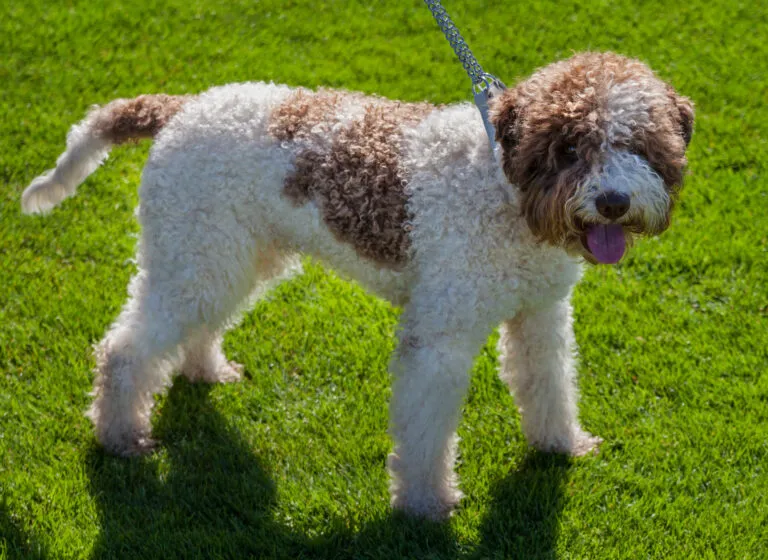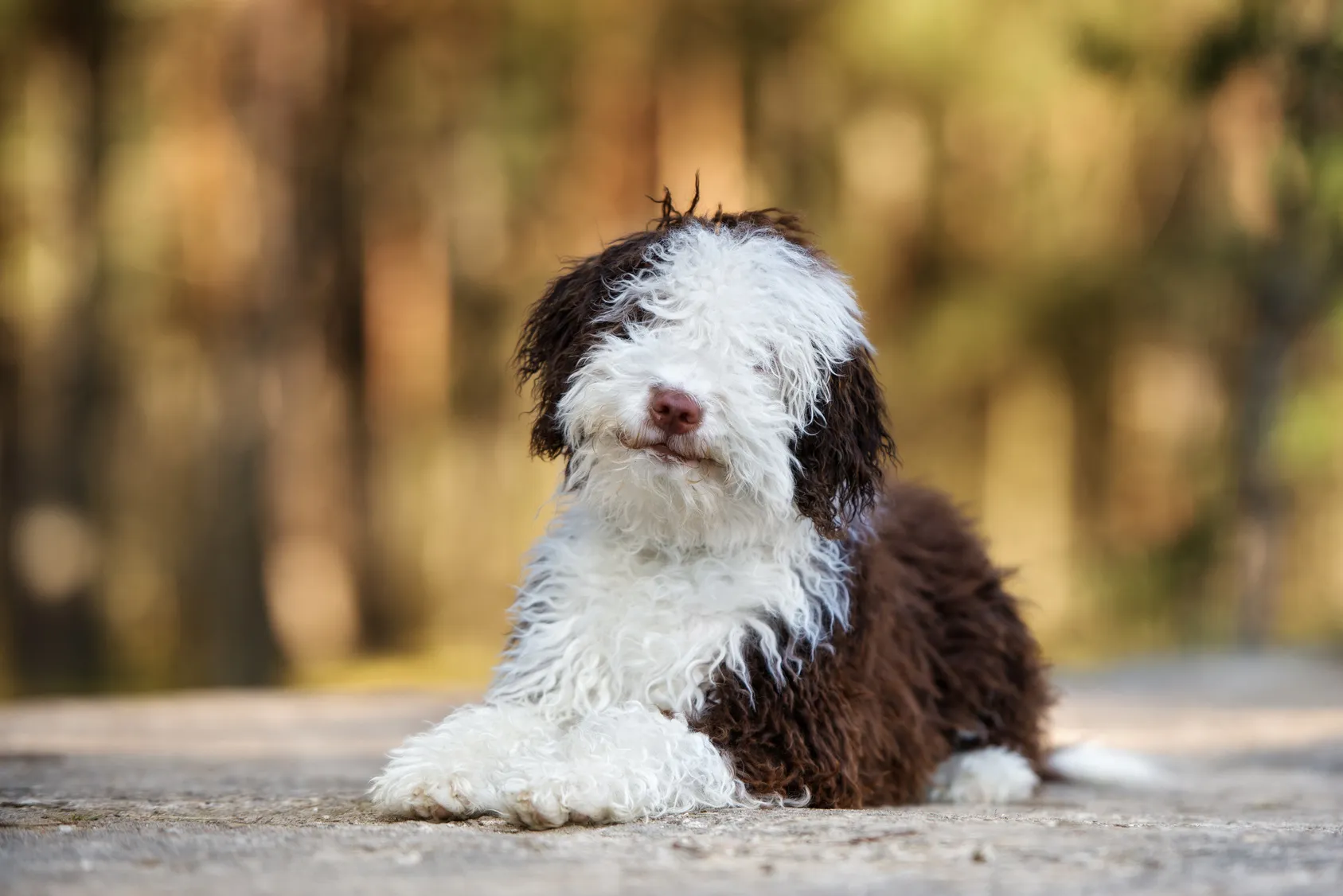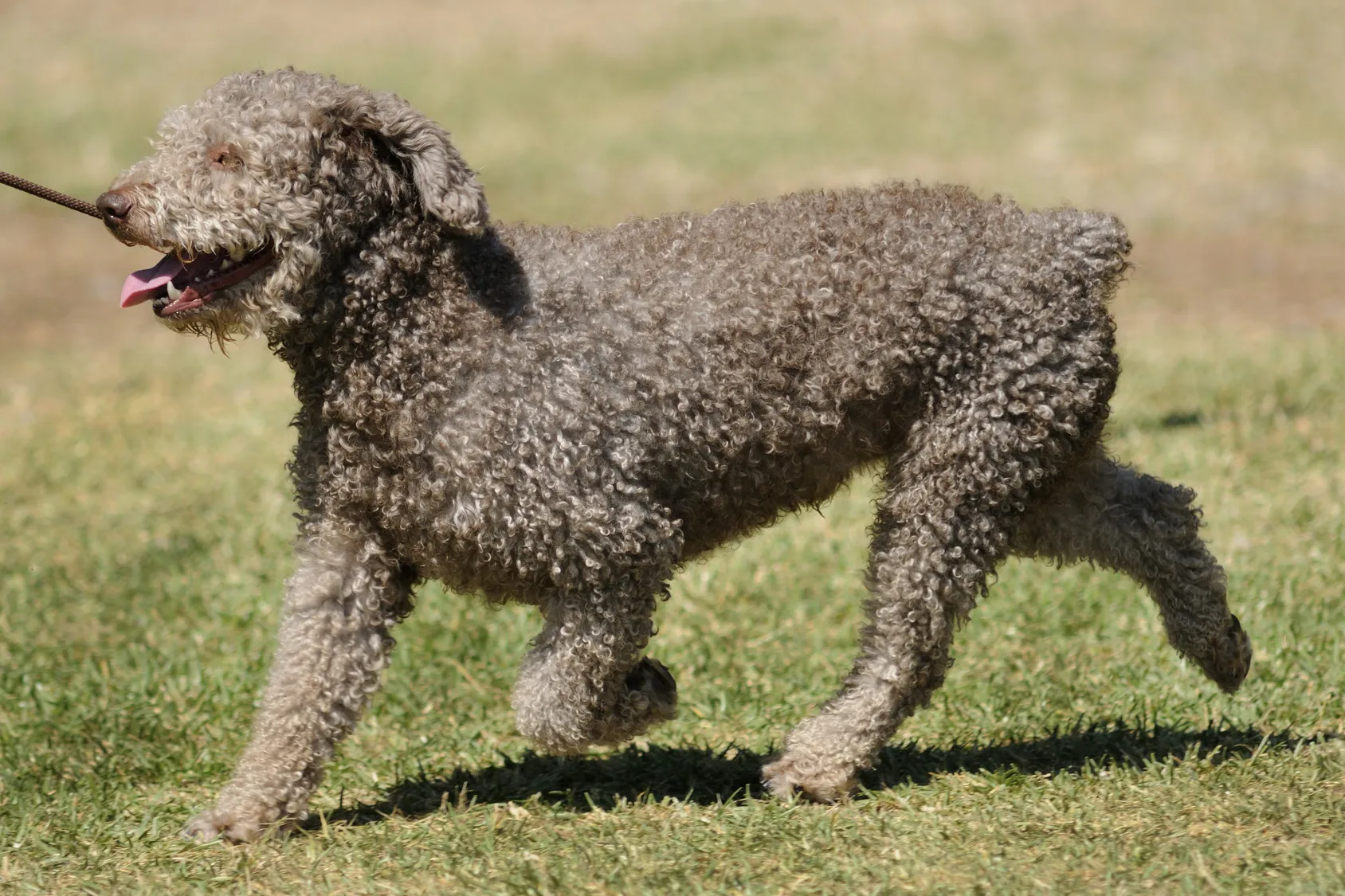Medium Size Poodle
Extremely clever, cheerful and adventurous, the Perro de Agua Español, known as the Perro or Spanish Water Dog for short, is a dog breed that soon captivates with its charm. It makes a good companion for sporty families.

© Ludmila Smite / stock.adobe.com
The tousled, rustic appearance is typical of water dogs, which is also true of the Perro de Agua Español. The fur of this breed is mostly shaved smooth all over. If the coat is left to grow, it forms cords. The double-layered fur with a thick undercoat provides ideal insulation for all water activities. According to the standard, the colours white, black and different brown tones, bicolour too, are permitted. These medium-sized dogs have a streamlined, well-proportioned physique, reaching up to 50cm in shoulder height and weighing around 20kg. Females are much smaller and daintier than males, as is usually the case with primal breeds.
Different varieties of water dogs have provided valuable service to the fishermen on all of Europe’s coasts. The Spanish Water Dog is originally from the marsh region of Andalusia, an environment to which it is ideally adapted. It isn’t clear how its ancestors arrived there. It is presumed that the Moors imported them from northern Africa or that they arrived later accompanying the Turks. In Andalusia, similar dogs were long known as Turkish dogs.
Amongst others, the Spanish Water Dog is closely related to the somewhat larger Portuguese Water Dog, the French Barbet and presumably the Hungarian Puli. As all-rounders, the ancestors of these dogs helped fishermen to collect nets and retrieve catches. In addition, they were considered outstanding herding dogs and hunting companions.
Targeted breeding is still in its early stages, having commenced in the 1970s. The Perro de Agua Español first took part in an exhibition in 1981 near Málaga, drawing attention to this hitherto unknown breed, which was not ultimately recognised by the FCI until 1999. Whilst they have since become more common in southern Europe, their popularity in the rest of Europe has grown slowly but steadily.
These versatile dogs bring great joy as they are very attentive and show quick comprehension. These attributes combined with their friendly nature makes them very likeable companions. However, they need plenty of activity so they don’t get bored, though they do enjoy rest periods and are even-tempered. Since they are intelligent and also happy to obey, training a Perro de Agua Español poses no serious challenge even for first-time dog owners, as long as they do research and most of all are consistent. Attending puppy play sessions and a dog school is a bonus, as long as you have found a suitable dog school that correlates with your training expectations. It’s worth starting to look before a puppy enters your home.
A healthy Perro is very robust, though its health requires suitable screening by a competent breeder. Due to the small gene pool, this risk of certain hereditary diseases is particularly high with this young breed.
Parent animals should verifiably have no hip problems before they are deployed for breeding. Get the breeder of your dream puppy to show you the test results of the parent animals in order to minimise the risk of hip dysplasia (HD). In addition, a genetic test for progressive retinal atrophy (PRA) should be carried out. This is an eye disease that can lead to blindness and the breed has a tendency to develop this. Carriers don’t necessarily fall ill themselves, but they can pass on the gene, which should be taken into consideration with pairings.
There have also been some cases of neuroaxonal dystrophy (NAD) affecting the breed. Since the disease emerges before the age of 18 months and manifests itself in the form of neurological deficits, the risk of affected dogs being deployed for breeding is low. However, there are carriers that don’t show symptoms, though thankfully there is a genetic test too. A healthy Perro can live to be 12 to 14 years of age.
 © otsphoto / stock.adobe.com
© otsphoto / stock.adobe.com
Your dog can tuck in if it gets a good deal of exercise – but please make sure it only does so after doing activities together in order to avoid the danger of stomach twist. Adapt the quantity of food to your companion’s energy consumption. The manufacturer’s indications found on the packaging can give you a broad guideline. Weigh your Perro de Agua Español every few weeks so you can react in a timely manner if it gains weight as an adult. If you give it treats, you should definitely calculate these as part of the daily intake if you’re watching your dog’s weight.
Not just quantity but quality too plays a significant role in an optimal canine diet: regardless of whether you choose wet food, dry food or both in alteration, choose a pet food with a high proportion of meat. This should be the main ingredient, whilst inappropriate ingredients like grain or sugar shouldn’t feature at all.
It’s worth looking into the topic of canine nutrition in more detail, since it is an important cornerstone for your four-legged companion living a long, healthy life. Fresh water should always be readily available to your dog. It’s worth taking a water bowl with you for longer trips.
The Spanish Water Dog barely moults, therefore lint brushes and pet hair vacuums can mostly stay hidden away. The Perro de Agua Español regularly has its fur cut short with most owners – a task that you can even do yourself with a good set of clippers following instructions. It doesn’t need combing, though you may have to remove small twigs or parasites from its fur if you let it crawl around outdoors. You can even let the fur grow longer and style the cords that result from this. However, this requires time and patience.
Giving your dog a bath with a mild dog shampoo every few weeks gets rid of dirt, though should only be done if necessary. If your Perro de Agua Español swims regularly, an extra bath is usually not needed.
Check your companion’s ears and claws – ear cleanser and claw clippers are useful accessories that you should know how to handle. Your vet can assist you or sort out the claws for you should this be required.
Boredom is an alien concept to owners of a Perro de Agua Español, since this sporty breed is suitable for numerous dog sports from agility to flyball and even dog dancing. Of course, not all dogs are alike – even amongst water dogs, there are individual preferences and dislikes. Experiment to see what you both enjoy most.
Your dog will happily take advantage of any opportunity to swim regularly, since this breed loves water. You can always teach it tricks both at home and out and about. The Perro also enjoys intelligence toys, which allow it to put its brains to the test. If you enjoy jogging, you can train an adult Perro de Agua Español and take it with you. It goes without saying that it enjoys accompanying you on long hikes. It also likes being involved with shorter bike rides or as a riding companion. The Spanish Water Dog is also well-suited to empathetic tasks, such as training to be a therapy or companion dog.
The Perro is a good fit for many dog lovers, though you should be sporty and frequently spend time outdoors. Couch potatoes won’t have fun with these nature-loving canines, though even-tempered water dogs also enjoy periods of calm with their human pack. The Perro de Agua Español is an excellent fit for families – also those with young children, who can find friends for life in these tousle-haired dogs. If they get enough exercise, you can keep dogs from this breed in a spacious apartment, although it’s better for them to at least have access to a garden in which they can frolic around freely. They will announce the presence of strangers but won’t resort to yapping. This breed can get on wonderfully with other pets once it has got used to them and is tolerant towards fellow dogs too.
 © avarand / stock.adobe.com
© avarand / stock.adobe.com
Dog lovers are often interested in water dogs because they have heard that they are hypoallergenic and therefore well suited to people allergic to pet hair. However, generalisations can’t be made on this subject. Instead, you should definitely take advice from a doctor beforehand and spend some time with a Perro de Agua Español if you are an allergy sufferer – ideally a few hours at the breeder’s home if you wish to take on a puppy.
Allergens are found in dogs’ skin flakes and saliva. The fact that this breed barely moults doesn’t necessarily make much of a difference. In addition, pollen can easily get stuck in the fur of these tousled-haired dogs. This can aggravate the symptoms of many sufferers of allergies to pet hair, since they often react to pollen too.
A Spanish Water Dog may be appropriate for allergy sufferers, but this is not always the case. In order to avoid disappointment, you should definitely investigate this aspect before the dog enters your home.
If you’ve fallen for this breed with its captivating nature, you should support its welfare by only purchasing puppies from a responsible breeder. These will value keeping the breed healthy and use their expert knowledge to choose the right animal to meet your goals. Dogs with firm characters need to spend time as puppies with the breeder, who will take responsibility for socialising them. Definitely don’t get involved with breeders focused on quantity over quality. You may be offered a supposed Perro de Agua Español at a bargain price without any paperwork!
Your new housemate is only allowed to leave its original home at the age of eight weeks at the earliest. It will then have been microchipped, vaccinated and dewormed on several occasions. Although the number of Spanish Water Dogs outside of Spain has increased in the last few years, the breed is still relatively rare. Hence, it’s possible that you may have to face long waits or journeys in order to find your dream puppy. Nevertheless, don’t make any compromises – after all, responsibility for a dog’s life begins with purchasing a puppy. Associations for (Spanish) water dogs can help you to find a breeder near to you.
It’s also best to find an adult Spanish Water Dog through such associations if you prefer this to a puppy. Second-hand dogs are always real characters. However, make sure to look into their previous history in detail, especially if you’re a first-time dog owner. It’s very much recommended to get acquainted with each other beforehand. Ideally you may go on a walk together, although this isn’t always possible when adopting a water dog from abroad. Animal protection associations re-home in particular water dog hybrids from Spain. Although they have no paperwork, they can still win you over with their charm. You absolutely must find out about the legal requirements for importing a dog from abroad and about the dangers that can be caused by the disease leishmaniasis, which occurs in southern Europe in particular.
We wish you plenty of joy with your Spanish Water Dog!
Fans of the Bearded Collie agree that those who aren't familiar with this dog breed simply have to get acquainted with it. And those who have experienced how a Bearded Collie bolts across meadows with its flowing fur, how it rolls around full of energy and joy and how it attentively and observantly takes into account its owners wishes become simply addicted to this original dog breed and its unique charm.
The Goldendoodle isn't a breed, but a pairing between Golden Retrievers and Medium or Standard Poodles. Marketed as a low-maintenance dog for allergy sufferers, this hybrid is enjoying increasing popularity amongst dog lovers, similar to the Labradoodle.